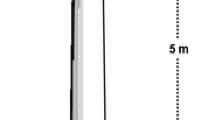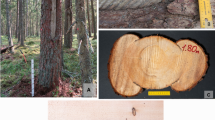Abstract
Tree care, especially pruning, is still mostly done in the dormant time. Such treatments expose live inner bark, the vascular cambium, and functioning outer sapwood to harsh external influences followed often by infection of pathogens. Investigations about response reactions of beech and oak to wounding made in different times of the year showed that wound closure was significantly slower for December and February wounds than in April and October. The length of discoloured sapwood was in October and December wounds greater than in February and April. Sapwood reaction expressed by the soluble phenol concentration index indicated however no significant differences among wounding dates. Overall, woundings in the vegetation period will be more effectively compartmentalized than in the dormant season. Consequently, tree care like pruning with many woundings should not be done in the winter period.





Similar content being viewed by others
References
Armstrong JE, Shigo AL, Funk DT, McGinnes EA, Smith DE (1981) A macroscopic and microscopic study of compartmentalization and wound closure after mechanical wounding of black walnut trees. Wood and Fiber 13:275–291
Boddy L, Rayner ADM (1983) Origins of decay in living deciduous trees: the role of moisture content and a re-appraisal of the expended concept of tree decay. New Phytol 94:623–641
Dujesiefken D, Ebenritter S, Liese W (1989) Wundreaktionen im Holzgewebe bei Birke, Buche und Linde (Wound reactions in the wood of birch, beech and basswood). Holz als Roh- und Werkstoff 47:495–500
Dujesiefken D, Peylo A, Liese W (1991) Einfluß der Verletzungszeit auf die Wundreaktionen verschiedener Laubbäume und der Fichte. Fostw Cbl 110:371–380
Herms DA, Mattson WJ (1992) The dilemma of plants: to grow or defend. The Quarterly Review of Biology 67:283–335
Jensen KF (1967) Oxygen and carbon dioxide affect the growth of wood-decaying fungi. For Sci 13:384–389
Jensen KF (1969) Oxygen and carbon dioxide concentrations in sound and decaying red oak trees. For Sci 15:246–251
Jurasek L (1958) Der Einfluß der Holztemperatur und Holzfeuchtigkeit auf die Thyllenbildung bei der Buche. Drev Vyskum 3:5–13
Liese W, Dujesiefken D (1996) Wound reactions of trees. In: Raychaudhuri SP, Maramosch K (eds) Forest Trees and Palms - Disease and Control. Oxford and IBH Publishing Co PVT LTD, New Delhi, India, pp 20–42
Shibata N, Harada H, Saiki H (1981) Development and structure of traumatic tyloses in Quercus serrata Thub L Development of traumatic tyloses in various boring seasons. Mokuzai Gakkaishi 27:618–625
Shigo AL (1984) Compartmentalization: A conceptual framework for understanding how trees grow and defend themselves. Ann Rev Phytopathology 22:189–214
Shortle WC (1979) Mechanisms of compartmentalization of decay in trees. Phytopathology 69:1147–1151
Shortle WC, Smith, KT, Dudzik KR, Parker S (1995) Response of maple sapwood to injury and infection. Eur J For Path 25:241–252
Shortle WC, Smith KT, Dudzik KR (1996) Decay diseases of stemwood: Detection, diagnosis and management. In: Raychaudhuri SP, Maramosch K (Eds.). Forest Trees and Palms - Disease and Control. Oxford and IBH Publishing Co PVT LTD, New Delhi, India, pp 95–109
Stamp N (2003) Out of the quagmire of plant defense hypotheses. The Quarterly Review of Biology 78:23–55
Trockenbrodt M, Liese W (1991) Untersuchungen zur Wundreaktion in der Rinde von Populus tremula L und Platanus x acerifolia (Ait) Willd. Angew Bot 65:279–287
Author information
Authors and Affiliations
Corresponding author
Rights and permissions
About this article
Cite this article
Dujesiefken, D., Liese, W., Shortle, W. et al. Response of beech and oaks to wounds made at different times of the year. Eur J Forest Res 124, 113–117 (2005). https://doi.org/10.1007/s10342-005-0062-x
Received:
Accepted:
Published:
Issue Date:
DOI: https://doi.org/10.1007/s10342-005-0062-x




